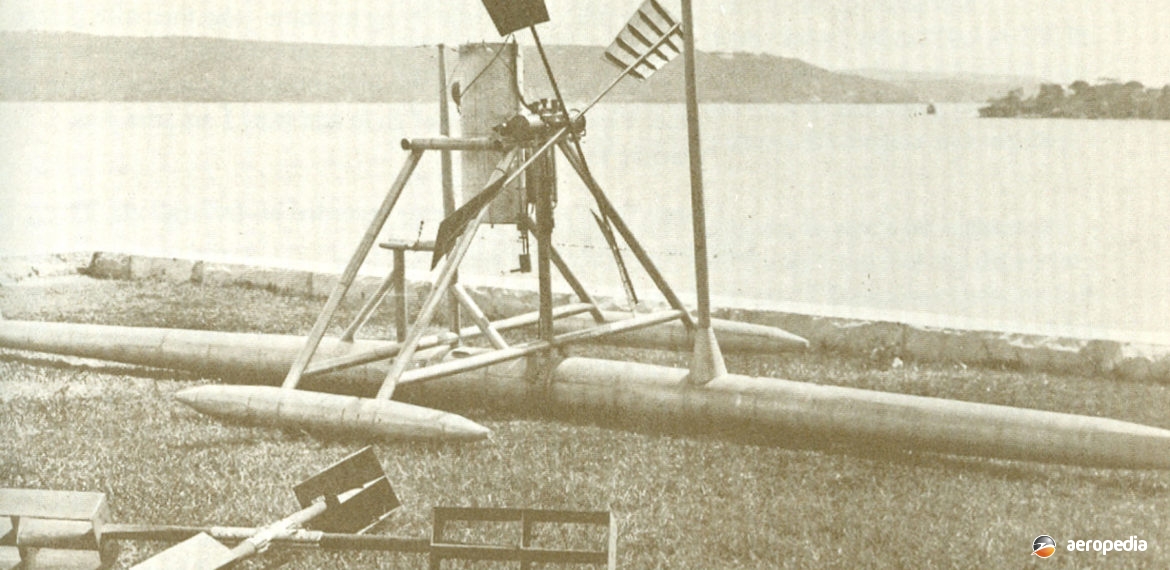Photograph:
Hargrave trimaran float flying machine (Author’s collection)
Country of origin:
Australia
Description:
Float equipped powered boxkite
Power Plant:
Steam engine
Specifications:
- TBA
History:
Lawrence Hargrave (1850 – 1915) has been described as an engineer, explorer, astronomer and aeronautical pioneer. He was born in Greenwich, England and emigrated to Australia with his family in 1865. He took on an engineering apprenticeship in Sydney. He worked as an engineer and became involved in exploration of remote parts of Australasia, at one stage taking up a post at the Sydney Observatory. He is most known throughout the world for his experiments with kites and flying machines. After the death of his father, with his inheritance he concentrated full-time on research at Stanwell Park on the New South Wales south coast at a site which offered excellent wind and hang-gliding conditions, which has become famous for paragliding in recent years.
Hargraves many and varied achievements are too great to note here but many articles, books, etc, have been published about his work. He was a pioneer whose plans and experiments helped others to build flying machines, some of these people acknowledging his efforts in this regard, others not. He gave lectures to the Royal Society of NSW and his research papers were published. He corresponded and exchanged information with other aeronautically-minded people in England, Europe and the United States. He was content that others should use his ideas and improve on them when building their flying machines. There is a memorial to him at Bald Hill overlooking Stanwell Park beach; and an engraving of him alongside a number of his gliders appeared on the reverse side of the Australian $20 banknote from 1966 to 1994.
Hargrave built hundreds of models of varying sizes, some with flapping wings like a bird, developing his designs up to a size which would carry a man. He also found man was not strong enough to operate flapping wings and proceeded to develop a number of engines to provide the necessary power. Amongst these was a tiny three-cylinder rotary engine driven by compressed air. From year to year he continued with development of aircraft, propellers and engines.
Even before Hargrave became airborne with his boxkites on 12 November 1894 at Stanwell Park, he had built and attempted to fly a tandem wing glider, this being a monoplane with a wing area of 13.93 m² (150 sq ft) but which was destroyed by a gust of wind in June 1894. In 1896 he was working on the design of what has been described as a float-equipped powered boxkite, this being two boxes with a centre fuselage containing a steam engine driving a four-blade propeller. There was a float at each extremity or corner. However, the steam engine was not of sufficient capacity to power the aircraft.
Hargrave designed a further machine, known as ‘the third machine’, in 1902. It was also a multi-boxkite aircraft fitted with floats, two under the forward wing and one under the rear, also to be fitted with a steam engine, this being reported to be his 25th steam engine design, but this was also found to be defective and the project was abandoned. He attempted to develop a rotary engine but was unable to produce a machine of sufficient power due to the weight of materials and the quality of machining available at the time. Another engine was a single-cylinder, two-stroke petrol unit.
A number of his models were presented to the Sydney Technological Museum, and others were taken to Germany and placed in the Deutsches Technological Museum in Munich but most of the 176 models in the museum were destroyed during Allied bombing in World War II. A total of 25 has survived and these have been restored and placed on display at the Powerhouse Museum in Sydney.

